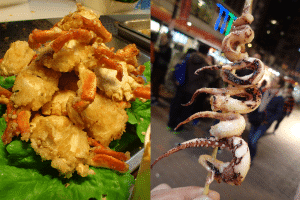- By Lisa Kadane

Spearfishing in Florida for lionfish is turning an invasive species into a dining delicacy.
With 18 venomous spines and an ability to float fearlessly, lionfish look more formidable than edible. But as Chef Irv Miller knows, there are tender filets under that tough exterior.
At his Pensacola restaurant, Jackson’s Steakhouse, Miller rubs the filets with a blend of spices and sear-sautés them quickly. He serves them with batter-fried “lionfish wings,” which is a more appetizing way of describing their meaty throats and the showy attached fin rays.
The dish’s presentation delights diners, but ultimately they’re won over by how lionfish taste. The white, delicate flesh is rich and buttery, like a cross between lobster and shrimp, or comparable to hogfish or snapper. “In many cities around the country, lionfish are still mysterious and a delicacy,” says Miller. “In Florida and throughout the Caribbean, they are more accessible and not so unusual. However, they are still considered fine-eating fish.”
Truth be told, lionfish shouldn’t even be on the menu in Florida—the invasive species is not native to Gulf, Caribbean, or Atlantic waters. Chef Miller is just one player working to tackle the problem by turning it into something tasty. His restaurant’s motto is ‘eat ‘em to beat ‘em.’

The flamboyant orange-and-white striped fish is native to the Indian and Pacific oceans around Indonesia. But during the 1980s, when lionfish could be purchased as aquarium fish in North America, some were likely released into the sea off the east coast of Florida.
With no natural predators—and an unsuspecting population of juvenile snapper, grouper, and triggerfish to feed on—the voracious invaders thrived and spread. Lionfish showed up on natural and artificial reefs off the Florida panhandle in 2010. “Some of our reefs are overwhelmed by lionfish,” says Robert Turpin, a marine biologist and the marine resources division manager for Escambia County, where Pensacola is located. “They are like a disease for which our ecosystem has no natural immunity.”
Not only do lionfish threaten local fisheries such as vermillion snapper, a keystone species, their unchecked numbers are bad for coral reefs. Lionfish prey upon algal grazers; fish that play an important role in keeping reefs free of algae growth that threatens to smother young coral polyps, says Turpin.
To fight lionfish proliferation, Turpin began working with the Florida Fish and Wildlife Conservation Commission (FWC) to incentivize their removal, and the first Lionfish Removal and Awareness Day was held in 2015. The annual event, held on May 20th and 21st this year in Destin, educates the public about the problem. It runs in conjunction with the Emerald Coast Open Lionfish Tournament (May 19-20), which offers cash prizes to encourage local spearfishers to go spearfishing for lionfish to help control their numbers (they can’t be bait-caught). “There’s no magic bullet to lionfish control,” says Turpin. “It really is a shotgun approach.”
Chef Miller got involved in the effort at about the same time and put lionfish on his dinner menu (when available) in 2014. “The Gulf of Mexico is precious to me,” says Miller. “Serving lionfish is my sustainable effort to give back.”
Restaurants in Destin also prepare the exotic fish in a number of appetizing ways during Lionfish Restaurant Week, the week of May 12-20. “We process the lionfish and provide restaurants with the filets for free,” explains Alex Fogg, a marine biologist, commercial spearfisher, and host of Lionfish Restaurant Week.
Participating establishments each have a night to serve the species, and diners can try such dishes as lionfish sushi, lionfish tacos, or coconut-crusted lionfish. “I call it the Bubba Gump of fish—there’s not a bad way to prepare it,” says Fogg. All together, the May events remove thousands of lionfish statewide, while simultaneously introducing diners to a delicious new fish.
While there’s been steady momentum toward controlling the problem and developing a sustainable lionfish market—Miller has been serving them off and on at Jackson’s Steakhouse for the past decade—challenges remain. Since lionfish can only be caught by spear divers, the harvests are as small as the eight- to 10-inch-long fish.
What’s more, divers are limited by how deep they can dive, and by how long they can stay underwater. Many lionfish are found at deep reefs beyond that range, compounding the problem. Hence, commercial operators aren’t keen to get in the lionfish game. Spearfishing for lionfish leaves divers between a rock and hard place.
Miller had been sourcing them from a commercial seafood supplier, but that company has paused operations to restructure, with plans to start up again in 2024. In the meantime, Miller will be forced to remove lionfish from the menu.
One promising solution could be lionfish-specific traps to target deepwater populations of the invasive species. A few designs have been trialed with success, says Fogg. “The next step is getting them into the hands of the people who actually fish with traps,” says Fogg, to see if commercial fishers can use them to capture enough lionfish to make it worthwhile.
Of course, supply is influenced by demand. The more people that try lionfish and fall in love with the improbable seafood delicacy, the more likely the tide will turn toward a reliable lionfish market. Will there be more anglers spearfishing for lionfish? Only time will tell.
Says Turpin: “Once people are aware of how good they taste, you’re more likely to convert another soldier in the fight.”

Spice-Crusted Lionfish, (Serves 4-6)
For the spice crust:
2 Tbsp. Panko bread crumbs
1 Tbsp. white sesame seeds
1 Tbsp. ground Guajillo chili powder
1 tsp. kosher salt
1 Tbsp. ground black pepper
1 Tbsp. ground cumin
1 Tbsp. ground coriander
For the lionfish:
8 (5- to 6-oz.) lionfish filets, skinless
4 Tbsp. vegetable oil
Spice-crust (recipe above)
1 medium cucumber, peeled and cut into spears
¼ cup ginger dressing (such as Makoto)
1 cup prepared jasmine rice
For the spice crust:Use a coffee grinder to pulse-grind the Panko fine. Then repeat for the sesame seeds. In a medium mixing bowl, combine ground Panko and sesame seeds with measured spices, and use a whisk to blend evenly. Set aside until needed.
For the lionfish: Combine cucumber spears with the ginger dressing and let sit in the refrigerator for one hour.Place a nonstick sauté pan over medium heat. Add vegetable oil. Dust the top side only of the filet meat into the spice crust mixture. Press gently and tap to remove access. Place the filets crust side down in the hot vegetable oil for 2 to 3 minutes, or until golden brown. Turn once, and cook the other side for one minute. Remove filets and place on a paper towel-lined plate. Serve immediately with rice and marinated cucumber spears.
Bluegill Fishing – Discover the Thrill of the ‘Gill
























